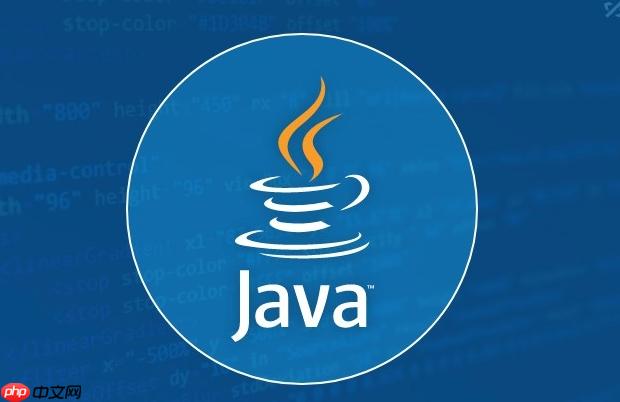java中实现分支逻辑的核心是if-else和switch语句,1.if-else适用于复杂布尔条件、范围判断及非离散值的场景,能处理任意逻辑组合;2.switch适用于基于离散值(如枚举、字符串、整数)的多分支选择,代码更整洁,尤其在java 14+使用switch表达式可直接返回值;3.三元运算符适合简单条件赋值;4.多态、策略模式、命令模式和函数式接口等高级方法可通过封装变化行为来替代显式条件判断,提升可维护性;5.优化技巧包括使用卫语句避免嵌套、提取条件为方法、用枚举和常量消除魔法值、利用optional处理null,选择合适方式需权衡逻辑复杂度与代码清晰度。

Java中实现分支逻辑,核心就是围绕
if-else
switch
在Java里,处理分支逻辑主要就是靠下面这些“工具”:
if-else
else
else if
&&
||
!
立即学习“Java免费学习笔记(深入)”;
// 基础 if-else
int score = 85;
if (score >= 90) {
System.out.println("优秀");
} else if (score >= 75) {
System.out.println("良好");
} else if (score >= 60) {
System.out.println("及格");
} else {
System.out.println("不及格");
}
// 嵌套 if
boolean isLoggedIn = true;
boolean isAdmin = false;
if (isLoggedIn) {
if (isAdmin) {
System.out.println("欢迎,管理员!");
} else {
System.out.println("欢迎,普通用户!");
}
} else {
System.out.println("请登录。");
}switch
switch
if-else if
case
case
break
case
// 经典 switch
String dayOfWeek = "Monday";
switch (dayOfWeek) {
case "Monday":
System.out.println("周一,努力工作!");
break;
case "Friday":
System.out.println("周五,准备周末!");
break;
default:
System.out.println("普通工作日。");
break; // 即使是default,也建议加上break
}
// Java 14+ 的 switch 表达式(更简洁,可以直接返回值)
int month = 2;
String season = switch (month) {
case 12, 1, 2 -> "冬季";
case 3, 4, 5 -> "春季";
case 6, 7, 8 -> "夏季";
case 9, 10, 11 -> "秋季";
default -> "未知月份";
};
System.out.println(month + "月是" + season);三元运算符(? :
if-else
int age = 18;
String status = (age >= 18) ? "成年人" : "未成年人";
System.out.println("他是一个" + status);这两种条件语句啊,虽然都能实现分支,但它们各自的“舒适区”可不一样。我个人觉得,理解它们的适用场景,比单纯知道怎么用更重要。
if-else
obj != null
obj.equals(anotherObj)
if-else
if (orderCount > 100 && totalAmount > 5000 || isPremiumMember)
switch
而
switch
switch
switch
if-else if
switch
switch
所以,我的经验是,如果条件是“这个或那个,或者那个”,并且这些“那个”是明确的、有限的几个值,考虑
switch
if-else
switch
case
if-else
写条件语句这事儿,看起来简单,但要写得既健壮又优雅,里头门道可不少。我这些年踩过的坑、学到的技巧,总结起来就是这么些:
常见的陷阱:
NullPointerException
if
null
if (user != null && user.getName().equals("张三"))user
null
getName()
switch
break
case
break
case
if
&&
||
!
if-else
if
switch
if (statusCode == 200)
switch (userRole) { case "ADMIN": ... }优化技巧:
尽早返回/卫语句(Early Exit/Guard Clauses):这是我个人最喜欢的一个技巧。对于那些不满足前提条件的情况,立即返回或者抛出异常。这样可以避免多层
if
// 优化前(箭头代码)
public void processOrder(Order order) {
if (order != null) {
if (order.getStatus() == OrderStatus.PENDING) {
if (order.getTotalAmount() > 0) {
// 核心业务逻辑
System.out.println("处理订单...");
} else {
System.out.println("订单金额不能为零。");
}
} else {
System.out.println("订单状态不正确。");
}
} else {
System.out.println("订单为空。");
}
}
// 优化后(卫语句)
public void processOrderOptimized(Order order) {
if (order == null) {
System.out.println("订单为空。");
return;
}
if (order.getStatus() != OrderStatus.PENDING) {
System.out.println("订单状态不正确。");
return;
}
if (order.getTotalAmount() <= 0) {
System.out.println("订单金额不能为零。");
return;
}
// 核心业务逻辑,现在非常清晰
System.out.println("处理订单...");
}提取复杂条件为方法:如果你的
if
// 优化前
if (user.getAge() > 18 && user.isPremium() && user.getLastLoginTime().isAfter(LocalDateTime.now().minusMonths(3))) {
// ...
}
// 优化后
if (isEligibleForSpecialOffer(user)) {
// ...
}
private boolean isEligibleForSpecialOffer(User user) {
return user.getAge() > 18 && user.isPremium() && user.getLastLoginTime().isAfter(LocalDateTime.now().minusMonths(3));
}使用枚举(enum
switch
switch
public enum OrderStatus {
PENDING, PROCESSING, COMPLETED, CANCELLED
}
// ...
OrderStatus status = OrderStatus.PENDING;
switch (status) {
case PENDING -> System.out.println("订单待处理");
case COMPLETED -> System.out.println("订单已完成");
// ...
}利用Optional
null
Optional
null
null
User user = getUserById(123); // 假设可能返回null
Optional.ofNullable(user)
.map(User::getName)
.ifPresent(name -> System.out.println("用户名为: " + name));使用常量代替魔法数字/字符串:把那些硬编码的值定义成常量,不仅提高了可读性,也方便统一管理和修改。
public static final int HTTP_STATUS_OK = 200;
// ...
if (statusCode == HTTP_STATUS_OK) {
// ...
}switch
switch
switch
case
除了最常见的
if-else
switch
多态(Polymorphism):这绝对是面向对象编程的精髓,也是解决复杂分支逻辑的“大杀器”。当你发现自己写了一大堆
if-else if
想象一下,你有一个
Shape
Circle
Rectangle
Triangle
// 传统方式(反模式)
public double calculateArea(Object shape) {
if (shape instanceof Circle) {
Circle c = (Circle) shape;
return Math.PI * c.getRadius() * c.getRadius();
} else if (shape instanceof Rectangle) {
Rectangle r = (Rectangle) shape;
return r.getWidth() * r.getHeight();
}
// ... 每次新增图形都要修改这里
return 0;
}使用多态,你可以在
Shape
getArea()
shape.getArea()
getArea()
if-else if
// 多态方式
interface Shape {
double getArea();
}
class Circle implements Shape {
private double radius;
public Circle(double radius) { this.radius = radius; }
@Override public double getArea() { return Math.PI * radius * radius; }
}
class Rectangle implements Shape {
private double width, height;
public Rectangle(double width, double height) { this.width = width; this.height = height; }
@Override public double getArea() { return width * height; }
}
// ...
public void processShape(Shape shape) {
System.out.println("面积是: " + shape.getArea()); // 不需要if-else判断类型
}这种方式,新增一个图形,只需要新增一个实现类,而不需要修改
processShape
策略模式(Strategy Pattern):这是一种行为设计模式,它允许你定义一系列算法,将每个算法封装起来,并使它们可以相互替换。这在处理不同行为的分支逻辑时非常有用。比如,你有一个订单处理系统,根据不同的支付方式(信用卡、支付宝、微信支付)有不同的处理逻辑。
你可以定义一个
PaymentStrategy
interface PaymentStrategy {
void pay(double amount);
}
class CreditCardPayment implements PaymentStrategy {
@Override public void pay(double amount) { System.out.println("信用卡支付: " + amount); }
}
class AlipayPayment implements PaymentStrategy {
@Override public void pay(double amount) { System.out.println("支付宝支付: " + amount); }
}
// ...
// 在业务代码中
PaymentStrategy strategy = new AlipayPayment(); // 或者根据条件选择
strategy.pay(100.0); // 统一调用接口方法这样,添加新的支付方式,只需要新增策略类,无需修改原有的支付处理逻辑。
命令模式(Command Pattern):这种模式将一个请求封装成一个对象,从而使你可用不同的请求、队列或日志来参数化客户端。它在处理需要撤销、重做或者队列化操作的分支逻辑时很有用。比如,一个菜单系统,每个菜单项对应一个不同的操作。
interface Command {
void execute();
}
class OpenFileCommand implements Command {
@Override public void execute() { System.out.println("打开文件..."); }
}
class SaveFileCommand implements Command {
@Override public void execute() { System.out.println("保存文件..."); }
}
// ...
// 在客户端代码中,可以根据用户输入选择并执行命令
Command command = new OpenFileCommand(); // 假设用户点击了“打开”
command.execute();函数式接口和Lambda表达式(Java 8+):对于一些简单的、基于输入执行不同操作的场景,可以利用
Map
if-else if
import java.util.HashMap;
import java.util.Map;
import java.util.function.Consumer;
public class ActionProcessor {
private final Map<String, Consumer<String>> actions = new HashMap<>();
public ActionProcessor() {
actions.put("print", System.out::println);
actions.put("log", msg -> System.out.println("LOG: " + msg));
actions.put("error", msg -> System.err.println("ERROR: " + msg));
}
public void process(String actionType, String message) {
Consumer<String> action = actions.get(actionType);
if (action != null) {
action.accept(message);
} else {
System.out.println("未知操作类型: " + actionType);
}
}
public static void main(String[] args) {
ActionProcessor processor = new ActionProcessor();
processor.process("print", "Hello World!");
processor.process("log", "Something happened.");
processor.process("unknown", "This won't work.");
}
}这里,我们用一个
Map
Consumer
if-else if
actionType
这些高级方法,本质上都是通过将“变化”的部分(即不同的行为)封装起来,并通过统一的接口或抽象来调用,从而减少代码中的显式条件判断。它们让代码更加灵活,更容易应对需求变化。当然,选择哪种方式,还是要看你的具体场景和项目规模,过度设计同样会带来不必要的复杂性。
以上就是java怎样用条件语句实现分支逻辑 java条件判断的实用编程技巧的详细内容,更多请关注php中文网其它相关文章!

java怎么学习?java怎么入门?java在哪学?java怎么学才快?不用担心,这里为大家提供了java速学教程(入门到精通),有需要的小伙伴保存下载就能学习啦!

Copyright 2014-2025 https://www.php.cn/ All Rights Reserved | php.cn | 湘ICP备2023035733号